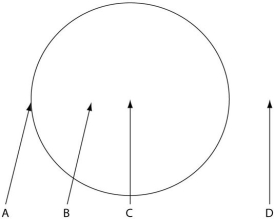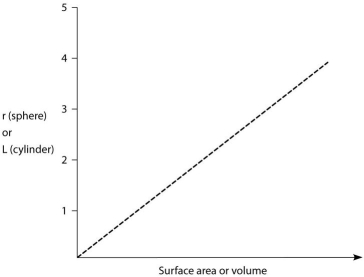A) nucleariids
B) choanoflagellates
C) zygomycetes
D) algae
E) diplomonads
G) B) and C)
Correct Answer

verified
Correct Answer
verified
Multiple Choice
The following figure depicts the outline of a large fairy ring that has appeared overnight in an open meadow, as viewed from above. The fairy ring represents the furthest advance of this mycelium through the soil. Locations A-D are all 0.5 metres below the soil surface. Responses may be used once, more than once, or not at all.
 -What is the most probable location of the oldest portion of this mycelium?
-What is the most probable location of the oldest portion of this mycelium?
A) A
B) B
C) C
D) D
F) B) and C)
Correct Answer

verified
Correct Answer
verified
Multiple Choice
Please refer to the following information to answer the next few questions. Diploid nuclei of the ascomycete, Neurospora crassa, contain 14 chromosomes. A single diploid cell in an ascus will undergo one round of meiosis, followed in each of the daughter cells by one round of mitosis, producing a total of eight ascospores. -If a single, diploid G₂ nucleus in an ascus contains 400 nanograms (ng) of DNA, then a single ascospore nucleus of this species should contain how much DNA (ng) , carried on how many chromosomes?
A) 100, carried on 7 chromosomes
B) 100, carried on 14 chromosomes
C) 200, carried on 7 chromosomes
D) 200, carried on 14 chromosomes
E) 400, carried on 14 chromosomes
G) A) and B)
Correct Answer

verified
Correct Answer
verified
Multiple Choice
In most fungi, karyogamy does not immediately follow plasmogamy, which consequently
A) means that sexual reproduction can occur in specialized structures.
B) results in multiple diploid nuclei per cell.
C) allows fungi to reproduce asexually most of the time.
D) results in heterokaryotic or dikaryotic cells.
E) is strong support for the claim that fungi are not truly eukaryotic.
G) None of the above
Correct Answer

verified
Correct Answer
verified
Multiple Choice
You are given an organism to identify. It has a fruiting body that contains many structures with eight haploid spores lined up in a row. What kind of a fungus is this?
A) zygomycete
B) ascomycete
C) deuteromycete
D) chytrid
E) basidiomycete
G) A) and B)
Correct Answer

verified
Correct Answer
verified
Multiple Choice
 -Some fungi can exist either as unicellular yeasts or as filamentous hyphae. Which of these forms would be most favourable in an environment where nutrients are limited?
-Some fungi can exist either as unicellular yeasts or as filamentous hyphae. Which of these forms would be most favourable in an environment where nutrients are limited?
A) a smaller unicellular yeast
B) a larger unicellular yeast
C) a shorter filamentous hypha
D) a longer filamentous hypha
F) C) and D)
Correct Answer

verified
Correct Answer
verified
Multiple Choice
The following figure depicts the outline of a large fairy ring that has appeared overnight in an open meadow, as viewed from above. The fairy ring represents the furthest advance of this mycelium through the soil. Locations A-D are all 0.5 metres below the soil surface. Responses may be used once, more than once, or not at all.
 -At which location should one find the lowest concentration of fungal enzymes, assuming that the enzymes do not diffuse far from their source, and that no other fungi are present in this habitat?
-At which location should one find the lowest concentration of fungal enzymes, assuming that the enzymes do not diffuse far from their source, and that no other fungi are present in this habitat?
A) A
B) B
C) C
D) D
F) A) and B)
Correct Answer

verified
Correct Answer
verified
Multiple Choice
If the fungus that produced the fairy ring can also produce arbuscules, then which of the following is most likely to be buried at location "C"?
A) septic tank
B) tree stump
C) deceased animal
D) fire pit
E) cement-capped well
G) A) and C)
Correct Answer

verified
Correct Answer
verified
Multiple Choice
Use the following information to answer the questions below. For several decades now, amphibian species worldwide have been in decline. A significant proportion of the decline seems to be due to the spread of the chytrid fungus, Batrachochytrium dendrobatidis (Bd) . Chytrid sporangia reside within the epidermal cells of infected animals, animals that consequently show areas of sloughed skin. They can also be lethargic, which is expressed through failure to hide and failure to flee. The infection cycle typically takes four to five days, at the end of which zoospores are released from sporangia into the environment. In some amphibian species, mortality rates approach 100%; other species seem able to survive the infection. -Apart from direct amphibian-to-amphibian contact, what is the most likely means by which the zoospores spread from one free-living amphibian to another?
A) by wind-blown spores
B) by flagella
C) by cilia
D) by pseudopods
E) by hyphae
G) B) and E)
Correct Answer

verified
Correct Answer
verified
Multiple Choice
Use the following information to answer the questions below. Rose-picker's disease is caused by the yeast, Sporothrix schenkii. The yeast grows on the exteriors of rose-bush thorns. If a human gets pricked by such a thorn, the yeasts can be introduced under the skin. The yeasts then assume a hyphal morphology and grow along the interiors of lymphatic vessels until they reach a lymph node. This often results in the accumulation of pus in the lymph node, which subsequently ulcerates through the skin surface and then drains. -Say S. schenkii had initially been classified as a deuteromycete. Asci were later discovered in the pus that oozed from an ulcerated lymph node, and the spores therein germinated, giving rise to S. schenkii yeasts. Which two of these are conclusions that make sense on the basis of this information? 1. S. schenkii produces asexual spores within lymph nodes. 2. S. schenkii should be reclassified. 3. S. schenkii continues to have no known sexual stage. 4. The hyphae growing in lymphatic vessels probably belonged to a different fungal species. 5. S. schenkii yeasts belonging to two different mating strains were introduced by the same thorn prick.
A) 1 and 3
B) 1 and 5
C) 2 and 3
D) 2 and 5
E) 4 and 5
G) B) and E)
Correct Answer

verified
Correct Answer
verified
Multiple Choice
Which of the following conditions is caused by a fungus that is accidentally consumed along with rye flour?
A) ergotism
B) athlete's foot
C) ringworm
D) candidiasis (Candida yeast infection)
E) coccidioidomycosis
G) C) and D)
Correct Answer

verified
Correct Answer
verified
Multiple Choice
What do fungi and arthropods have in common?
A) Both groups are commonly coenocytic.
B) The haploid state is dominant in both groups.
C) Both groups are predominantly heterotrophs that ingest their food.
D) The protective coats of both groups are made of chitin.
E) Both groups have cell walls.
G) B) and C)
Correct Answer

verified
Correct Answer
verified
Multiple Choice
Both fungus-farming ants and their fungi can synthesize the same structural polysaccharide from the β-glucose. What is this polysaccharide?
A) amylopectin
B) chitin
C) cellulose
D) lignin
E) glycogen
G) A) and C)
Correct Answer

verified
Correct Answer
verified
Multiple Choice
Which of the following is a characteristic of hyphate fungi (fungi featuring hyphae) ?
A) They acquire their nutrients by phagocytosis.
B) Their body plan is a unicellular sphere.
C) Their cell walls consist mainly of cellulose microfibrils.
D) They are adapted for rapid directional growth to new food sources.
E) They reproduce asexually by a process known as budding.
G) B) and D)
Correct Answer

verified
Correct Answer
verified
Multiple Choice
Which of the following has the least affiliation with all of the others?
A) Glomeromycota
B) mycorrhizae
C) lichens
D) arbuscules
E) mutualistic fungi
G) A) and C)
Correct Answer

verified
Correct Answer
verified
Multiple Choice
Fossil fungi date back to the origin and early evolution of plants. What combination of environmental and morphological change is similar in the evolution of both fungi and plants?
A) presence of "coal forests" and change in mode of nutrition
B) periods of drought and presence of filamentous body shape
C) predominance in swamps and presence of cellulose in cell walls
D) colonization of land and loss of flagellated cells
E) continental drift and mode of spore dispersal
G) A) and B)
Correct Answer

verified
Correct Answer
verified
Multiple Choice
Use the following information to answer the questions below. For several decades now, amphibian species worldwide have been in decline. A significant proportion of the decline seems to be due to the spread of the chytrid fungus, Batrachochytrium dendrobatidis (Bd) . Chytrid sporangia reside within the epidermal cells of infected animals, animals that consequently show areas of sloughed skin. They can also be lethargic, which is expressed through failure to hide and failure to flee. The infection cycle typically takes four to five days, at the end of which zoospores are released from sporangia into the environment. In some amphibian species, mortality rates approach 100%; other species seem able to survive the infection. -Sexual reproduction has not been observed in Bd. A Bd sporangium initially contains a single, haploid cell. Which of the following processes must be involved in generating the multiple zoospores eventually produced by each sporangium? 1. S phase 2. cytokinesis 3. mitosis 4. meiosis
A) 1 and 2
B) 1 and 3
C) 2 and 3
D) 1, 2, and 3
E) 1, 2, and 4
G) A) and D)
Correct Answer

verified
Correct Answer
verified
Multiple Choice
The following questions refer to the description below. A lichen is a mutualistic association between a fungus and a green algae or cyanobacteria. There are clear morphological differences in lichen body form; some have flat bodies and are very close together, others have leaf-like bodies, and still others grow upright. The association between the two organisms is so complete that lichens are classified as a single organism. -Biologists have noted that lichen structure differs substantially from the fungus component grown separately. What is the most plausible explanation for this?
A) The variation depends on the structure of the hyphae.
B) The variation depends if reproduction is sexual or asexual.
C) The variation is due to the photosynthetic partners which influence lichen structure.
D) The variation depends on the coevolution of the partners.
E) The variation depends where the lichens are found.
G) None of the above
Correct Answer

verified
Correct Answer
verified
Multiple Choice
Use the following information to answer the questions below. Recent genetic studies of the structure of microsporidian genomes, as well as the sequences of their tubulin genes and the gene for RNA polymerase II, indicate that microsporidians are closely related to the fungi. Microsporidians lack flagella, centrioles, peroxisomes, and mitochondria (although they do have degenerate mitochondria, called mitosomes) . They have the smallest genome of any eukaryote, and it is a genome that changes quickly. The genome is contained within two haploid nuclei. All microsporidians are obligate intracellular parasites. They use a unique organelle called a polar filament to gain access to the cells of their hosts. One species causes chronic diarrhea in AIDS patients. Another parasitizes Anopheles gambiae, the mosquito that transmits a fatal form of malaria to humans. -Given the eukaryotic structures they lack, it should be expected that microsporidians also lack
A) the "9 + 2 pattern" of microtubules.
B) chitin.
C) lysosomes.
D) nuclei.
E) centrosomes.
G) C) and E)
Correct Answer

verified
Correct Answer
verified
Multiple Choice
The adaptive advantage associated with the filamentous nature of fungal mycelia is primarily related to
A) the ability to form haustoria and parasitize other organisms.
B) avoiding sexual reproduction until the environment changes.
C) the potential to inhabit almost all terrestrial habitats.
D) the increased probability of contact between different mating types.
E) an extensive surface area well suited for invasive growth and absorptive nutrition.
G) A) and C)
Correct Answer

verified
Correct Answer
verified
Showing 21 - 40 of 97
Related Exams